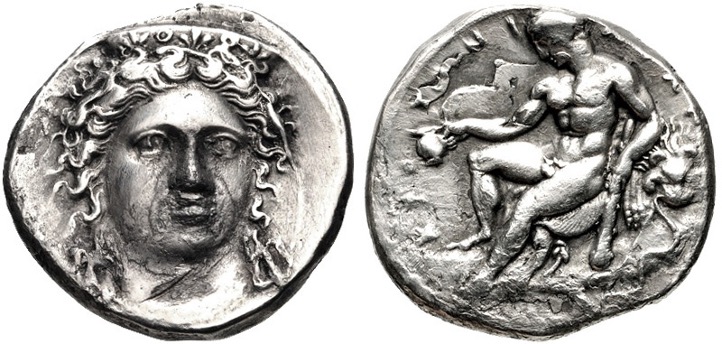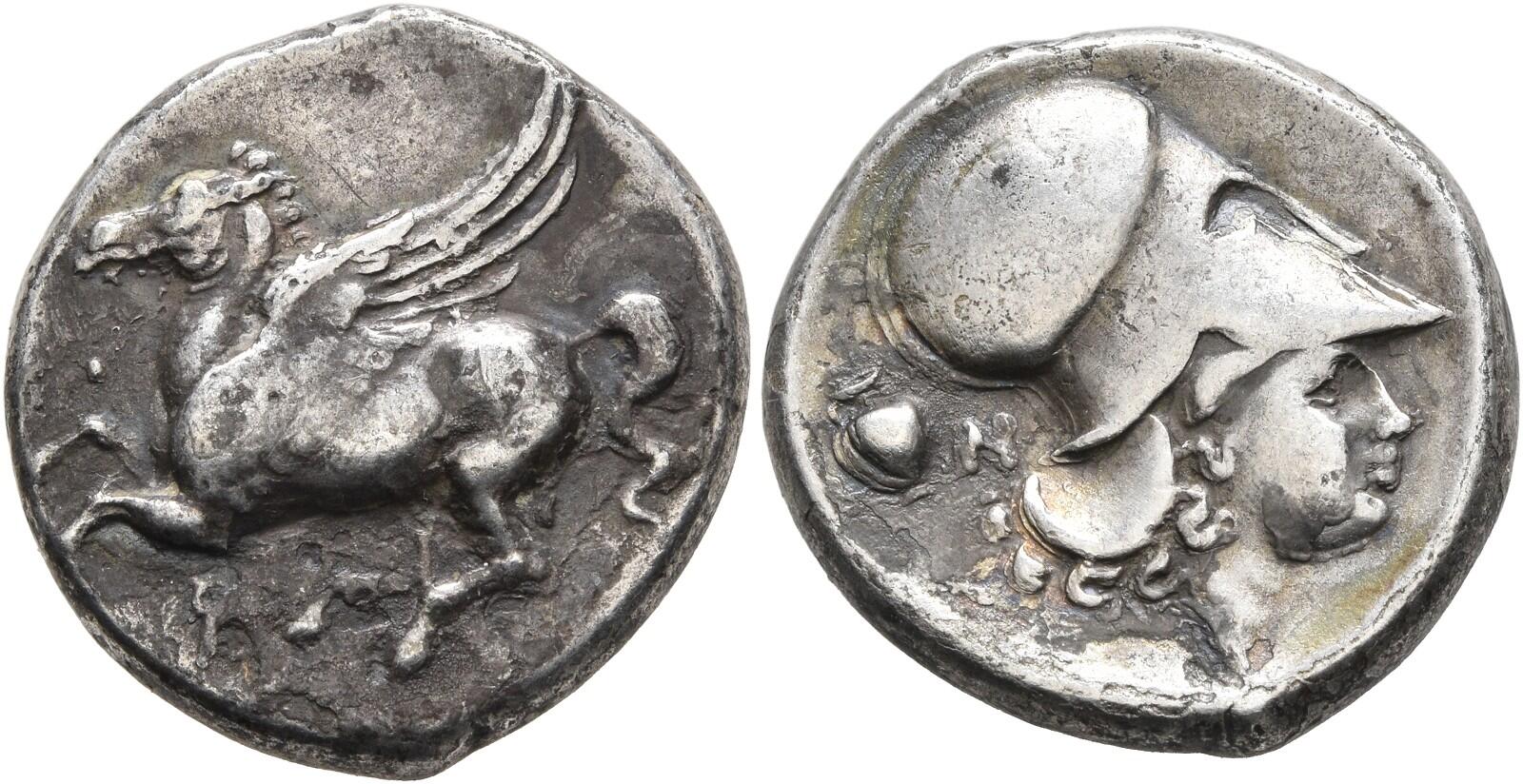400 BCE - 325 BCE | ΚΡΟΤΩΝΙΑΤΑΣ
Overstriking coin
SO 1397 - Croton over uncertain mint.jpg
[1],
[2]
Overstruck variety
Corinth (head r.).jpg
|
|
Sale(s)Sale(s) ᵖ:
|
Classical Numismatic Group, EA 292, 5 Dec. 2012, 109 = Rauch, EA 10, 15 July 2011, 35
|
|
|
|
Description
| ObverseInscription or printing placed on the obverse.:
|
Head of Hera Lakinia facing slightly right, wearing stephane decorated with palmette
|
ReverseInscription or printing placed on the reverse.:
|
ΚΡΟΤΩΝΙΑΤΑΣ (Greek) Young Herakles, nude, reclining left on lion skin draped over rock, holding cup and club. Against the rock, bow.
|
Mint and issuing power
| MintIdentifies the place of manufacture or issue of a numismatic object.:
|
Croton
|
Ancient regionAncient region.
|
Bruttium
|
Modern countryModern country: Italy
|
AuthorityIdentifies the issuing power. The authority can be "pretended" when the name or the portrait of X is on the coin but he/she was not the issuing power. It can also be "uncertain" when there is no mention of X on the coin but he/she was the issuing power according to the historical sources:
|
|
Chronology
| FromIdentifies the initial date in a range assigned in a numismatic context. 400 BCE toIdentifies the final date in a range assigned in a numismatic context.. 325 BCE
|
Classical 480-323 BC  periodTime period of the numismatic object. periodTime period of the numismatic object.
|
Physical description
MetalThe physical material (usually metal) from which an object is made.: Silver 
|
WeightWeight of the numismatic object (in grams). in grams: 7.657.65 g <br />7,650 mg <br />
|
DenominationTerm indicating the value of a numismatic object. Examples: tetradrachm, chalkous, denarius.: nomos
|
AxisDescribes the directional relationship between the obverse and reverse of a numismatic object.: 77 mm <br />0.7 cm <br />
|
| DiameterDescribes diameter of an object (in mm).: 2121 mm <br />2.1 cm <br />
|
StandardStandard.: Achaian
|
References
Description
| ObverseInscription or printing placed on the obverse.:
|
Pegasus (visble on reverse: rump and tail above Herakles’ outstretched arm)
|
ReverseInscription or printing placed on the reverse.:
|
Head of Athena.
|
Mint and issuing power
| MintIdentifies the place of manufacture or issue of a numismatic object. ᵖ:
|
Corinth
|
Ancient regionAncient region. ᵖ
|
Corinthie
|
Modern countryModern country: Greece
|
AuthorityIdentifies the authority in whose name (explicitly or implicitly) a numismatic object was issued. ᵖ:
|
|
Chronology
| FromIdentifies the initial date in a range assigned in a numismatic context. toIdentifies the final date in a range assigned in a numismatic context..
|
periodTime period of the numismatic object.
|
Physical description
| DenominationTerm indicating the value of a numismatic object. Examples: tetradrachm, chalkous, denarius. ᵖ:
|
stater 
|
|
|
References
| Frequency of overstrikesFrequency of overstrikes:
|
rare and concentrated
|
Level of confidenceLevel of confidence of the identification:
|
sure
|
| RemarksRemarks:
|
"Overstruck on a Corinthian-type stater with Pegasus rump and tail visible above Herakles’ outstretched arm."
|
References
- ^ Rutter N. Keith et alii (eds.) (2001), Historia Numorum Italy, London, xvi, 223 p., 43 pl.
- ^ Hoover, Oliver D. (2018), The Handbook of Greek Coinage Series, Volume 1. Handbook of Coins of Italy and Magna Graecia, Sixth to First Centuries BC., Lancaster-London, 2018, lxi, 527 pages, 23 cm
- ^ Ravel, Oscar E (1936), Les "Poulains" de Corinthe : monographie des statères corinthiens. Tome I: de 650 à 415 J.-C., Basel.
- ^ Calciati, Romolo (1990), Pegasi, Mortara, Edizioni I.P..

